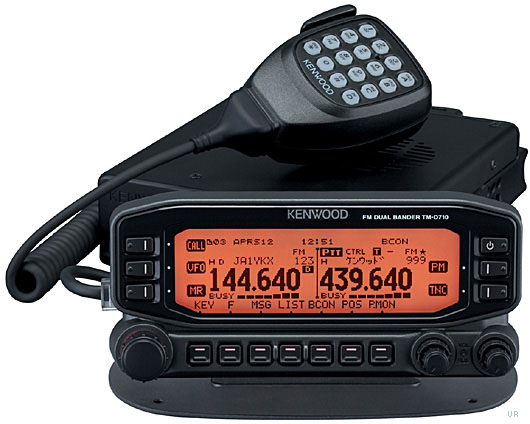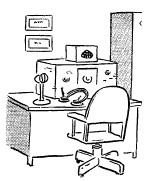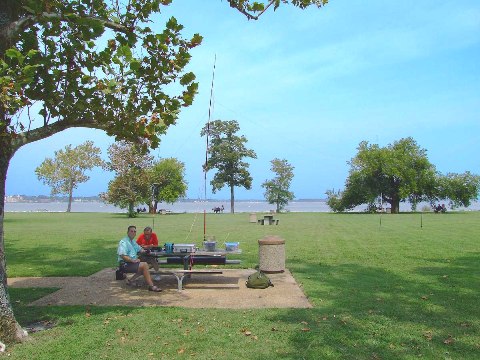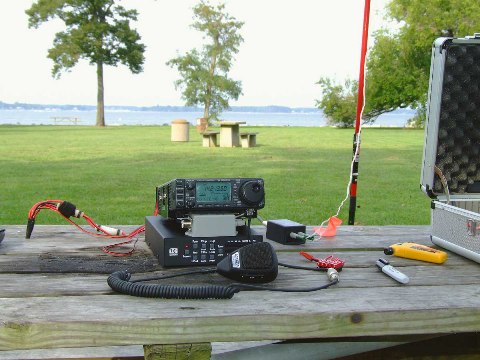
I was able to interface my TM-D710A with UI-View32. Previously I was using UI-View32 along with a Kantronics KPC-3+ and a dedicated FM rig (FT-1500) with a direct packet connection. This set up worked well – UI-View32 puts the KPC-3+ into KISS mode and the rest of the settings are pretty straight forward. The advantage of using the TM-D710A (one of many) is that with its two radios in one I can run my APRS station and also get on the local repeaters while only using my one VHF/UHF antenna.
I use Weather Display in conjunction with my Davis Vantage Pro2. Weather Display is an amazingly powerful application and it works well with UI-View32, allowing my APRS station to transmit my weather data in addition to my position info.
Configuring TM-D710A and UI-View32 to work together is little more tricky.
The TM-D710A has a built-in TNC. When you use the TM-D710A in a mobile configuration, the TNC runs in APRS mode. When used with UI-View32, the TNC operates in standard packet mode. It looks like it is possible to use the TNC in KISS mode, but I am not sure how to do that with UI-View32. The directions from Kenwood for the TM-D710A include a recommended CMD file to be used with UI-View32. I used the recommended CMD file and UI-View32 and the TM-D710A worked together up to a point. What was missing were two TNC commands that allow UI-View32 to see the received APRS traffic and then display the traffic on the UI-View32 map. Here is what the CMD file looks like now:
;This is a sample TNC initialization file for use with
;the Kenwood TM-D710A.
[SETUP]
;DON’T alter anything in this section unless you are
;sure you know what you are doing!
COMMAND_PROMPT=cmd:
COMMAND_CHARACTER_CODE=3
ESCAPE_CHARACTER_CODE=
CONV_COMMAND=CONV
MYCALL_COMMAND=”MYCALL ”
UNPROTO_COMMAND=”UNPROTO ”
NO_BEACON_COMMAND=BEACON EVERY 0
[INIT_COMMANDS]
^C^C^C
;Control mode on.
TC 1!TS 1
;Select TNC PKT mode on A band.
TN 2,0!TN 2,0
;Waiting for command prompt.
^M!cmd:!5
;Repeating the first two commands is not an error!
ECHO OFF
BEACON EVERY 0
ECHO OFF
BEACON EVERY 0
;Also UI-View32 to see incoming APRS traffic
MON ON
MCOM ON


 Went up to the
Went up to the 

 I want to put together an inexpensive APRS WX station for my dad, KD6EUG, to install up at his cabin in
I want to put together an inexpensive APRS WX station for my dad, KD6EUG, to install up at his cabin in  At around 9PM on May 31, 1978 were the first KNOWN transmissions of Packet over Amateur Radio. The location was Bill Wong’s Restaurant in Montreal, Canada.
At around 9PM on May 31, 1978 were the first KNOWN transmissions of Packet over Amateur Radio. The location was Bill Wong’s Restaurant in Montreal, Canada.  This site is dedicated to the people providing emergency and backup communications in VA using Amateur Radio Digital modes. This is done by amateur radio operators on their own time and at their own expense as a public service to their communities and the state. VDEN supports both ARES and RACES operations. The primary 1200 baud frequencies are 145.73 and 446.075 with the UHF used as a backbone and forwarding frequency whenever possible. 441.050 (9600bps) is used for high speed connections from the greater Fredericksburg area, to the VA EOC and on down to the greater Tidewater area. Any frequency may be used for local operations but a link to 145.73, 441.050 or 446.075 is a must for relaying messages to the VA EOC. Keyboarding should NEVER be used during an activation or drill on 145.73! The ability of keyboarding to literally bring a network to a halt is as well known as is the infamous “dead carrier” that pops up during drills and activations. We also have Pactor operations as needed. When the network is not operating under a activation or drill, it functions as a normal statewide network. The term “network” is used to describe the emergency communications package that VDEN brings to Virginia. If you want to join the private, no spam, VDEN list server for system updates and information, please send me an
This site is dedicated to the people providing emergency and backup communications in VA using Amateur Radio Digital modes. This is done by amateur radio operators on their own time and at their own expense as a public service to their communities and the state. VDEN supports both ARES and RACES operations. The primary 1200 baud frequencies are 145.73 and 446.075 with the UHF used as a backbone and forwarding frequency whenever possible. 441.050 (9600bps) is used for high speed connections from the greater Fredericksburg area, to the VA EOC and on down to the greater Tidewater area. Any frequency may be used for local operations but a link to 145.73, 441.050 or 446.075 is a must for relaying messages to the VA EOC. Keyboarding should NEVER be used during an activation or drill on 145.73! The ability of keyboarding to literally bring a network to a halt is as well known as is the infamous “dead carrier” that pops up during drills and activations. We also have Pactor operations as needed. When the network is not operating under a activation or drill, it functions as a normal statewide network. The term “network” is used to describe the emergency communications package that VDEN brings to Virginia. If you want to join the private, no spam, VDEN list server for system updates and information, please send me an 


